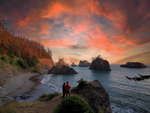Nestled in the depths of Hell Roaring Canyon, just outside of Canyonlands National Park's Island in the Sky District, lies one of the area's more fascinating pictograph panels. The Barrier Canyon style rock art known to some as Comet Thrower, and to others by Comet Catcher, features a large six-fingered anthropomorphic figure with what appears to be a yellow comet or fireball hurling towards it.


Trailhead elevation 5,085'
Water None
Don't miss the pictographs a few hundred feet to the left of Comet Thrower
Hiking to Comet Thrower
There are multiple routes that will eventually get you to the Comet Thrower Panel, but for this article I'll focus on the most adventurous option. It's the shortest of three known routes, but has some exposure to it. Those with a fear of heights should consider looking into a different route.
The unsigned trailhead for the hike is located at the end of a dirt road near coordinates 38.633190, -109.864037, 30 minutes from downtown Moab. In dry conditions, any vehicle can reach the trailhead. After parking, walk to the canyon rim and study the wall on the opposite side. The suggested route is highlighted below. Studying the canyon wall will likely help in your route finding efforts later.

Then, head left and follow the canyon rim for roughly 0.4 miles until you reach coordinates 38.6292660, -109.8652145. The photo below is what you should see.

From here you'll want to drop down both of the ledges near the bottom of the photo above. Each ledge is no more than 5' tall and easy to navigate. Once below the two ledges, walk towards the canyon rim and off to the right you'll find a small window in the cliff.

Pass through the window and on the other side you'll find the ledge shown in the photo below.

At this point you'll need to shimmy on your belly between the two rock slabs and the ceiling of the ledge.

The clearance between the rock slabs and ceiling is about 2-1/2 feet, so it's a fairly sight spot, but very manageable. Once you're past the two rock slabs you'll be able to crouch down and make your way across the ledge.

The ledge is 3' wide at its narrowest and 5-6' wide at its widest. There is some exposure, but you should never be in any danger of falling off if you're careful. Once you're through the ledge you'll need to route find down the canyon, which is fairly easy. If the descent that you're taking ever looks sketchy you're probably not taking the best route down. Eventually you'll find a well traveled trail that leads down to the bottom of the canyon through a series of fairly steep switchbacks. Once at the bottom of the canyon the trail continues toward the Kachina Spires in the photo below

Around 1 mile into the hike the trail ends at a wash where you'll make a right and follow the wash for less than a half mile before the trail reemerges on the right. A few hundred feet after exiting the wash and re-establishing yourself on the trail you'll pass by a very large boulder to the left and find the alcove in the photo below to your right. The panel is located inside the alcove at the top of a modest rockfall.

The Comet Thrower himself is about as tall as the average person and is flanked by other odd depictions as well as the comet. The yellow ochre used in the comet stands out well. What's tough to capture in a photo are the number of wavy yellow lines that surround Comet Thrower. They almost appear as though an aura surrounding the image. They're pretty faint, but in person you can make them out fairly well when the sun isn't shining directly on the panel. The depictions to the right of the Comet Thrower are closely outlined in yellow ochre, which might suggest that the wavy lines around the main figure represent something significant. The figure below the comet has no yellow pigment, which might indicate that it was created before or after the other images. The photo below gives a good idea on how large the figures are.

The panel is well known as Comet Thrower, however the comet, if that's what it is, appears to be hurling towards the anthropomorphic figure, not away from it. Whichever you prefer to call it, the panel is definitely one of the more fascinating panels in the area. The close up below makes it a bit easier to make out the Comet Thrower's six fingers and the faint yellow lines around the upper portion of the figure.

The yellow ochre near the Comet Thrower's feet is much more pronounced.

A close up of the comet.

There are a few more pictographs along the same wall, including a very dark figure and two smaller depictions. To reach these, simply walk left along the wall and down the rockfall where you'll find them at ground level.

When you're taking in the views simply return the way you came. The open area near the trailhead provides some awesome backcountry camping options, so keep that in mind. The panel is best viewed late in the day when the sun isn't directly on the panel. Arrive any earlier and the finer details of the panel, including the aura-like lines around the Comet Thrower, are pretty tough to make out. If pictographs interest you, there are numerous sites to visit in the nearby area. Among them are the Bartlett Rock Art, Intestine Man, and Snake in Mouth sites.
_edited.png)






















